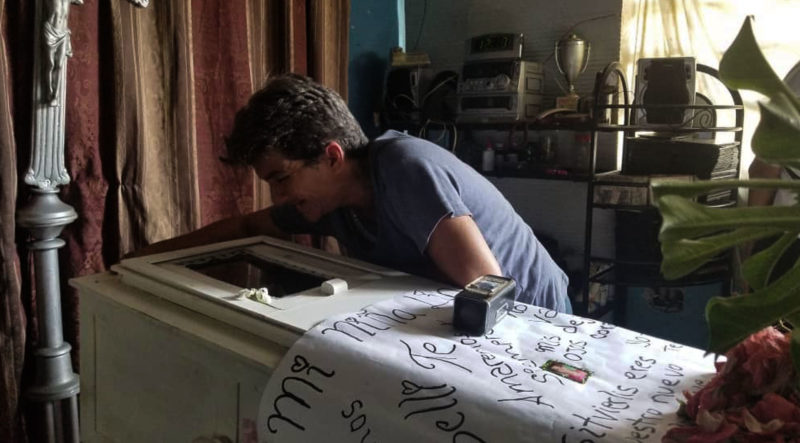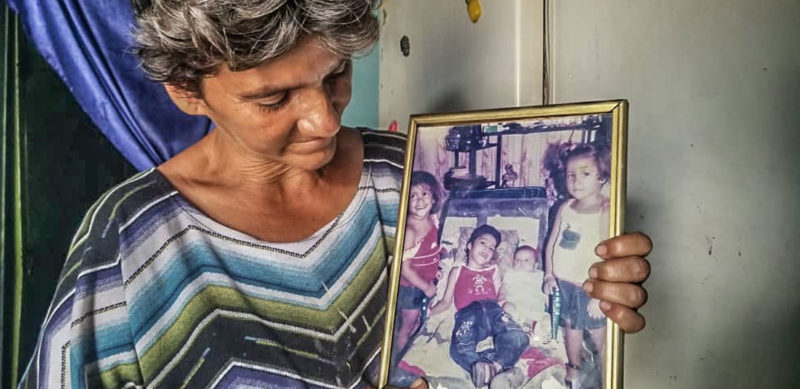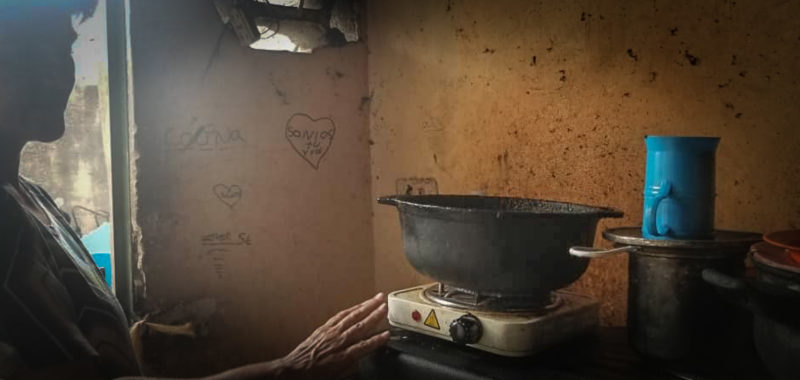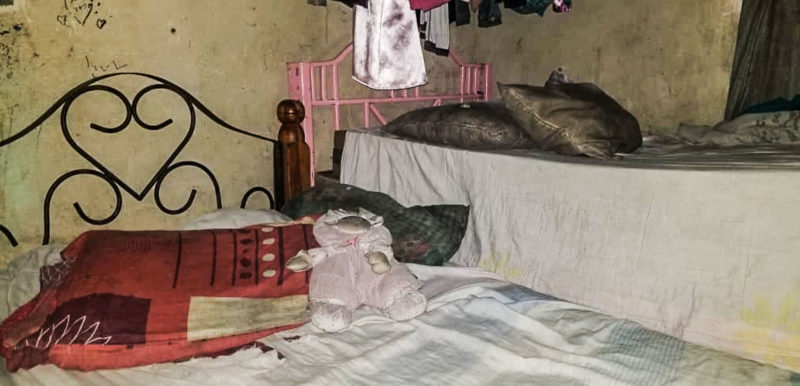Chronicles of Us, Part 6: The Doll
This story, which happened during the national blackout of March, focuses on the drama for a single family and the extent of the complex humanitarian emergency, in all its horror.


Photos: Heberlizeth González
The first general blackout in March went for over 48 hours, which felt more like 48 days. I’m a journalist and I had to report what was happening, I just couldn’t stay at home. At 7:00 p.m., I packed some food and water and asked Carlos, my husband, to drive me around.
Social media was ripe with chilling stories of patients dying in powerless hospitals, so we went to the Central Hospital, here in Valencia. Everything was dark outside, but the place itself had electricity, thanks to its power generator. I stayed until 10:00 p.m. and was almost going home when the car’s headlights flashed a woman walking in the shadows.
She was carrying something in her arms, but I couldn’t see what it was. A child, a teenager? Carlos stopped right beside her and I rolled down the window to try to make things out in the darkness. “I’m going to leave her in the morgue,” she said. “Yes, she’s my daughter. She’s dead.”

Gitsy’s arms were used to carrying her adult daughter’s 10 kilograms. Gitverlis, the girl, had turned 19 only four days before, but she looked small and frail like a child. Valencia, 2019. Photo: Heberlizeth González
A hotdog and a banana
Gitsy’s arms were used to carrying her adult daughter’s 10 kilograms around. Gitverlis, the girl, had turned 19 only four days before, but she looked small and frail like a child.
She was born on March 5th, 2000. That day, Gitsy also had to walk a long stretch with her daughter, not in her arms but in her belly. After walking for miles, in pain, she reached this very same Central Hospital. By some kind of miracle, she didn’t give birth in the street. A doctor inserted a towel in her vagina to stop the process because she couldn’t see Gitsy when she arrived. Hours later, when Gitverlis was born, her skin, fingernails, and lips were swollen. The late birth marked her for life: a year later, she was diagnosed with brain paralysis. She had to be under treatment ever since.
Gitverlis went through some of it at an Integral Diagnostics Center (CDI) near her home, until she was 12 years old and an inexperienced Cuban doctor broke her hip during a poor procedure. They didn’t return after that.
Due to her condition, Gitverlis also required a special diet. She had to take vitamins, proteins, and supplements that Gitsy couldn’t afford; by 2016, she’d stopped taking Pediasure and the only proteins she was ingesting came from lentils. It was harder and harder to get a balanced diet.
On the night of March 8th, 2019, Gitsy was walking aimlessly through the dark streets of Valencia with Gitverlis in arms, and the youngest of her three other children, looking for something to eat. A man gave them a hotdog, their supper: Each of them took a bite. At 10:00 p.m., Gitsy gave Gitverlis a banana she received at a fruit shop.
Gitverlis’s belly swelled up. She belched and threw up. Looking at her mom, she asked for help and Gitsy knew something was wrong. At dawn on March 9th, the mother went through different healthcare centers, but none had power. Her only hope was the Central Hospital, but reaching it was difficult—the streets of her neighborhood were blocked with people protesting the blackout.

“My daughter’s ill, I’m taking her to the Central Hospital,” Gitsy said. “I’ve taken her to other places but they can’t see her without electricity.” Valencia, 2019. Photo: Heberlizeth González
Gitsy felt her daughter was dying, so she carried her and started walking. On the side of the road, a woman pulled over and asked her where she was heading. “My daughter’s ill, I’m taking her to the Central Hospital,” Gitsy said. “I’ve taken her to other places but they can’t see her without electricity.”
“Get in, ma’am, I’ll take you,” said the woman.
The girl barely had vital signs. They tried to reanimate her on the floor of the ER, but the equipment wasn’t working properly, even though it was connected to the power generator.
Gitverlis was dead.
The camera
They say the brain has a hard time assimilating loss. Perhaps that’s why Gitsy was untroubled by the news: She picked up her daughter from the floor and took her to the hospital’s morgue. No doctor had certified the death, so the morgue didn’t take the body. Gitsy carried the body back to the ER, where a doctor suggested her to visit a CDI for the paperwork.
“Walking? In this darkness? No, doctor, I can’t!” she said.
The doctor just told her to get back to the morgue and walked away.
Not knowing what to do, after the morgue rejected them, Gitsy went to the pediatric emergency, where they also denied them entry because of Gitverlis’s age. She went back to the morgue and that’s when I saw her.
I got out of the car, recording the interview with my phone. I felt odd; my legs were shaking. I looked at her through the camera and, every now and then, pulled my eyes off the screen to actually see her. I was perplexed by this woman with the skin sticking to her bones, carrying her dead daughter. Calm, tearless. She said she lived in Trapichito, a slum in Southern Valencia. A hospital worker interrupted the interview to tell Gitsy that the morgue would take the child, and she followed him.
I made it back home, caught mobile signal and I uploaded the video on social media. I wasn’t expecting the landslide that came in: outlets from Colombia, Mexico, Peru, the U.S., Panama, Germany, France and Israel (among others) were sharing the material. I got dozens of messages from news agencies, journalists and followers, an endless string of questions: “Is it true? Did you record this? Do we have your permission to publish it? How can we help the lady?” Many were as shocked as I was at the woman’s stoicism through that horror.
Some even thought that the video was fake. I don’t blame them. It was played 50,000 times on Instagram alone.

Reporting Gitverlis’ death resulted in violence from GNB officers to the reporters who had interviewed her family. Valencia, 2019. Photo: Heberlizeth González
The white casket
I felt committed to this family. I knew Gitsy couldn’t afford funeral expenses so, on March 10th, in the ongoing blackout, I went to Trapichito. I didn’t know where she lived, but people pointed me in the right direction. I was going to guide a group sent by a politician who told me he’d take care of the funeral expenses, disappearing shortly after. I spoke with Gitsy at length and she confirmed that she lacked the money for the funeral and the burial. The Valencia Mayor’s Office could pay for the latter, but not the former.
I promised her that Gitverlis, “Owl Eyes,” as the neighbors called her, would have her funeral.
That very night, the messages of solidarity poured in on my social media post. “God is there for everyone,” wrote a man called Francisco, who owned a funeral parlor and told me he’d take care of everything. Gitverlis had been in the morgue for almost 24 hours.
Near 9:00 p.m., when I finally got home with my husband through a city ablaze with street protests, I realized two National Guard armored vehicles and a jeep were tailing us. “We’re the press, we’re the press!” I shouted, thinking that it would help us; it caused the opposite effect. Carlos was beaten out of the car.
The first thing I did was hide the phone, where I had every bit of information about Gitverlis’s death. “Give us the phone or we’ll kill him,” the officer holding Carlos at gunpoint told me, hitting him over and over.
The leader of the squad didn’t say his last name, but he was very clear: “We have orders to kill anyone.”
Fearing they’d shoot him, I surrendered my phone, and a sergeant yelled at me to give him my password. Once they had access to the files, they erased the recordings and gave the phone back, taking another one we had in the car and letting us go.

The collapse of the basic services has affected the daily life of many Venezuelan families. The extent of the humanitarian crisis can be told through the many horrors that have taken place amidst the collapse. Valencia, 2019. Photo: Heberlizeth González
I had trouble sleeping that night. I was afraid but also reinforced in my conviction to report the truth. I rested for a short while and returned to Gitsy’s house the next day, to tell her the news about Francisco and his team.
On March 13th, the white casket was in Gitsy’s living room, surrounded by flowers. There were neighbors and friends, and even some politicians. Someone put up a speaker with the opening theme of El Chavo del 8, Gitverlis’s favorite TV show.
Just then, Gitsy collapsed.
“My girl, my girl! Get up, honey. Get up!” she cried.
Later, she told me that those scenes come back to her from time to time. She relives it over and over. Every night she sleeps hugging her girl’s rag doll. She says she misses her enormously. She was her whole world for 19 years, and now she doesn’t know what to do with so much spare time. She’s weighed down by the absence of that frail body she carried for so long.

Every night she sleeps hugging her girl’s rag doll. She says she misses her enormously. Valencia, 2019. Photo: Heberlizeth González
This story, originally published on La Vida de Nos, is part of the project La Vida de Nos Itinerante, where people from all over the country take part in workshops to improve their skills to tell real stories. Pictures by Heberlizeth González. Translated by Javier Liendo.
Caracas Chronicles is 100% reader-supported.
We’ve been able to hang on for 21 years in one of the craziest media landscapes in the world. We’ve seen different media outlets in Venezuela (and abroad) closing shop, something we’re looking to avoid at all costs. Your collaboration goes a long way in helping us weather the storm.
Donate



